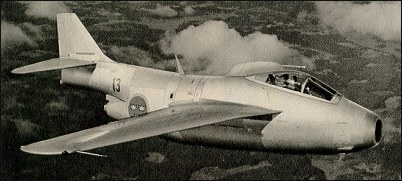|
| Saab's original project for the Saab-29
had envisaged it as a conventional monoplane powered by a de Havilland Goblin turbojet, but information on German swept-wing research which became available soon after the end of hostilities in Europe (combined with development of the more powerful de Havilland Ghost turbojet) resulted in redesign to incorporate these features. As the company had no experience of the behaviour of a swept wing it was decided to use a Saab Safir lightplane to test a wing of this configuration, a reduced-scale wing with 25° of sweep-back being installed and flown on this aircraft. Negotiations were initiated with de Havilland for licence-production of the Ghost turbojet in Sweden. The first of four Saab-29 prototypes was flown initially on 1 September 1948, but it was not until the spring of 1951 that the aircraft was ordered into production, being the first aircraft in its class to be production-built in Western Europe. Of cantilver shoulder-wing monoplane configuration, the Saab-29 had retractable tricycle landing gear, its powerplant mounted within the rotund fuselage, and with the pilot accommodated on an ejection seat in a pressurised cockpit.
Saab J 29A fighters began to enter service with the Flygvapen later in 1951, the type remaining in production until
April 1956, by which time a total of 661 had been built. They remained in service until 1958 when their gradual replacement by the Saab-32 Lansen began, and in 1961-2 30 ex-Flygvapen J 29Fs were supplied to Austria.
 | A three-view drawing (1651 x 986) |
| CREW | 1 |
| ENGINE | 1 x DH "Ghost 50", 22.6kN |
| WEIGHTS |
| Take-off weight | 6000 kg | 13228 lb |
| DIMENSIONS |
| Wingspan | 11.0 m | 36 ft 1 in |
| Length | 10.1 m | 33 ft 2 in |
| Height | 3.8 m | 12 ft 6 in |
| Wing area | 24.0 m2 | 258.33 sq ft |
| PERFORMANCE |
| Max. speed | 1060 km/h | 659 mph |
| Ceiling | 15700 m | 51500 ft |
| ARMAMENT | 4 x 20mm cannons, missiles |
| lxbfYeaa, e-mail, 15.11.2025 14:49 20 reply | | lxbfYeaa, e-mail, 14.03.2024 05:24 20 reply | | Barry, 16.09.2013 18:51 The availability of the Ghost engine gave the designer Lars Brising and his team the higher performance which made this machine so successful. Produced in A,B,D,E and F forms and not to mention the S29C photo reconnaissance version the first operational Tunnens were fielded by F13 at Norrkoping in May 1951. They were used in the Congo by the U.N. between 1961 and 1963, and as noted 30 ex J29F's were sold to the Austrian Air Force between 1961 and 1962. reply | | Johan Runfeldt, e-mail, 27.05.2010 08:07 They were replaced as fighters by the Draken during the first half of the 1960s, served as advanced trainers at the RSwAF Air War Academy (F20) in Uppsala. Later they served as target-tugs until the early 1970s, final operational sortie being flown in 1974.
The Flying Barrel marks the zenit of RSwAF power and glory, in the period the J29 was in the first line RSwAF was considered the fourth strongest air force in the world. reply | |
| | Hans Stråhle, e-mail, 14.03.2010 22:04 I don't know myself how long they were in service but they certainly were in service in the summer of 1959 when I was an air force boy scout for three weeks on the island of Gotland where there was a group (division) of eight (possibly more) stationed for the summer. A great summer for us! reply | | paul scott, e-mail, 17.08.2009 18:48 Another fine (Well among the first) of Saab's line of excellent fighter types. A strange shape but still handled like a dream apaarently. reply |
|
Do you have any comments?
|
| 
COMPANY
PROFILE
All the World's Rotorcraft
|







